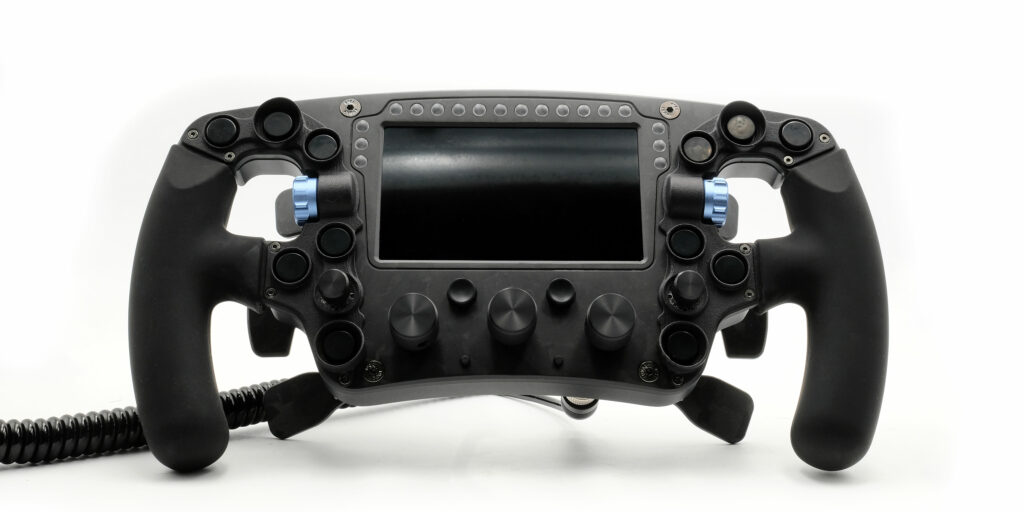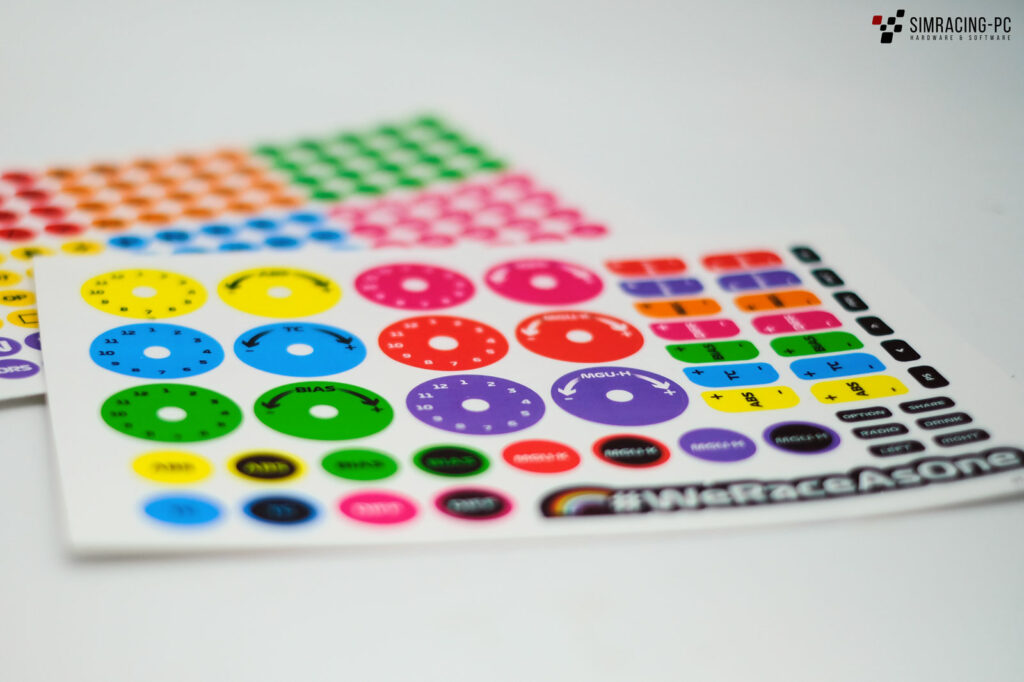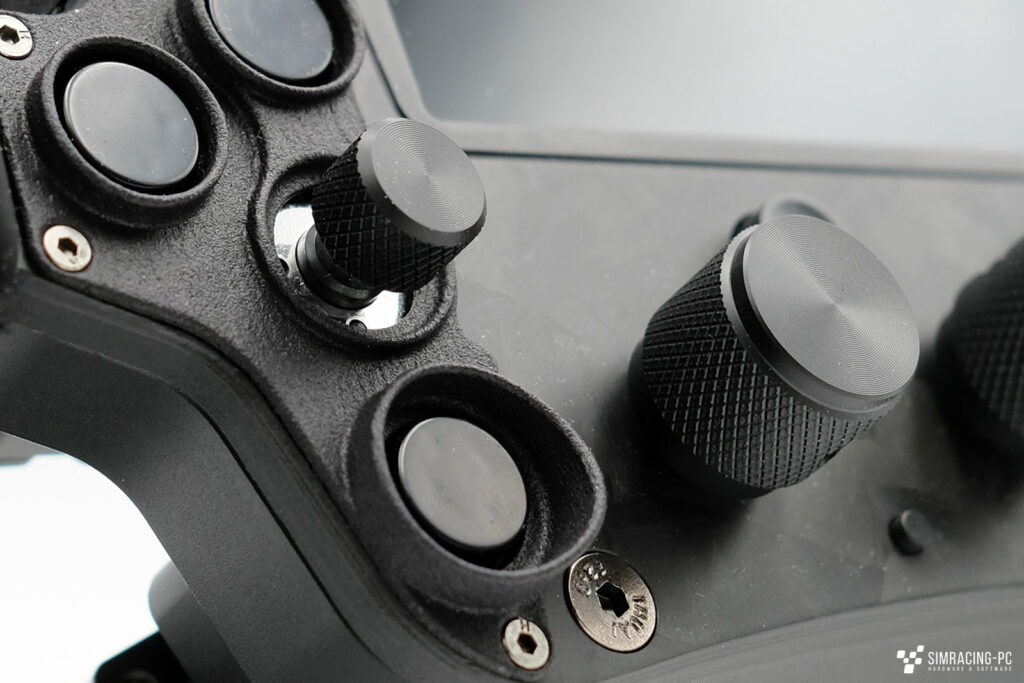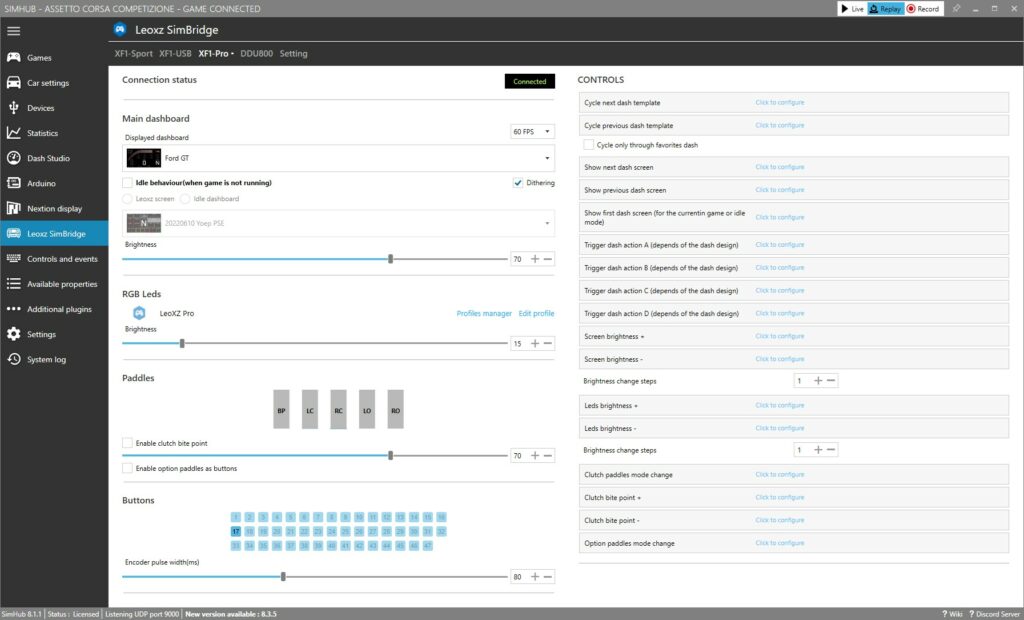Leoxz XF1 Pro Steering Wheel – Review
The XF1 Sport from Leoxz was one of the biggest surprises last year. Will Leoxz be able to take it up a notch with the Pro version, or would you rather go for the old model?

Ordering and shipping
The XF1 Pro can be ordered directly from the manufacturer’s website in China. Taxes, customs and shipping costs (to Germany 99€ for air freight with 7 – 10 days delivery time) are then added to the prices.
- XF1 Pro – Shifter Only: 519.95€
- XF1 Pro – Shifter & Clutch 559.95€
- XF1 Pro – Shifter & Clutch & Option: 599.95€
In addition, you can also order a matching QR:
- Fanatec QR: 60€
- MOZA QR: 45€
- Simagic QR: 45€
- Thrustmaster QR: 40€
For buyers from the EU, buying from a local dealer is in many cases more favourable. Sim-Motion, for example, offers the steering wheel in various pre-configured packages:
- XF1 Pro – Shifter & Clutch
- Fanatec QR: 739€
- Thrustmaster QR: 719€
- MOZA QR: 719€
- Simagic QR: 719€
- XF1 Pro – Shifter & Clutch & Option
- Fanatec QR: 789€
- Thrustmaster QR: 759€
- MOZA QR: 769€
- Simagic QR: 769€
Note: The steering wheel tested here was provided directly by Leoxz. There was no influence on the review. There were also no requirements regarding the content of the review or the time of publication.
Scope of delivery
The steering wheel is shipped in a discreet white box with Leoxz branding. Inside is the well-padded steering wheel itself as well as a USB cable, stickers with tweezers and an M3 Allen key.
- XF1 Pro Steering Wheel (Quick release optional)
- USB-XS9 Cable
- Custom Stickers
- M3 Allen Key
- Nylon Tweezers


Compatibility
Due to the 70 mm bolt circle on the back of the steering wheel, it is basically compatible with all common systems. The holes are alternately threaded and unthreaded. With the optional QR made for Fanatec gear the steering wheel can be used directly without the Fanatec Podium Hub. The same applies to the Ecosystem from Thrustmaster.
Leoxz specifies the following systems as compatible:
- Simucube SC1, SC2
- Fanatec DD1, DD2, CSW, CSL DD, DD Pro (Base torque needs to be unlocked with PHUB or Leoxz Fanatec QR, while connecting through USB)
- Simagic Alpha, Alpha Mini
- Moza R16, R9, R5
- Thrustmaster T300, T500, TX, TS-XW, T-GT, T-GT II, and TS-PC (Only support bases that do not require official steering wheel authentication).
In contrast to the XF1 Sport, the Pro version is designed for operation with the supplied USB cable. Here, it is recommended to connect the device either directly to the PC or to a USB hub with its own power supply to enable trouble-free operation.
Scope of functions
Function keys
The steering wheel is equipped with the following function keys:
- 14 buttons, four of which have additional button guards. There are two somewhat smaller buttons above the three encoders in the lower area. The buttons have a clearly defined pressure point throughout and are pleasant to press.
- 3 encoders at the front with additional push function. The aluminium caps feel good to the touch and look very high-quality.
- 2 thumb encoders, which are very easy to reach and are also equipped with aluminium caps.
- 2 buttons below the encoders on the front.
- 2 funky switches (click left right, up down, turn left, turn right, push).
The biggest and most important innovation here are the two fully-fledged funky switches. These are a clear improvement over the previous model, which had an analogue joystick and a normal button instead of the two funkys. Here, Leoxz has definitely responded to the wish of the community, which has been heard over and over again.



Paddles
Apart from the lack of real funky switches, the positioning of the shift paddles was one of the few points of criticism of the XF1 Sport. Here, too, the manufacturer has reacted and installed a slightly modified block in the XF1 Pro, on which the 3-millimetre-thick carbon paddles are mounted. These, as well as the paddles of the optional double clutch and the additional analogue option paddles, can be further adapted to one’s own needs via slotted holes.
The two magnetic shifters can be operated much more comfortably due to the additional distance and indicate the successful shifting process after a relatively short actuation travel with a discreet but quite loud clicking sound.
The analogue shift paddles correspond in design to the predecessor model and can be configured either as a combined axis (double clutch with adjustable bite point) or as separate axes. A spring is used here to generate the resistance with which the contactless paddles can be finely dosed, for example as a clutch for a standing race start. This works very well in practice, the analogue axes can be operated smoothly and the resistance provided by the spring is very well chosen in its strength.
The optional paddles can be configured either as analogue axes or as buttons. Even though we would have liked normal paddles with a simple click better during testing, they can be very handy depending on the intended use. For example, you can put the throttle and brake on the option paddles and drive completely without connected pedals.

Display and LEDs
Another improvement awaits us in the area of the display. Instead of a 4.3-inch IPS display with a resolution of 480 x 272 pixels, a VoCore display is now installed. This has a significantly higher resolution of 800 x 480 pixels for the same screen size. To overcome the design-related weaknesses of the display currently used by many manufacturers, Leoxz relies on a combination of an in-house software extension for Simhub (Simbridge) and a higher-quality chip compared to the standard display. This allows significantly higher frame rates (60 FPS instead of a maximum of 30 FPS) to be achieved, and software dithering is also possible. The latter enables significantly finer colour gradients (see example picture). The manufacturer provides a detailed explanation of the approach in a blog post (link).
This time, a total of 18 RGB LEDs are used, which are spread in the following way:
- 3 LEDs left
- 12 LEDs centre
- 3 LEDs right
Instead of relying on single-colour LEDs with fixed functions, they are now all adjustable and their colour is also freely configurable. Compared to the XF1 Sport, most users will gladly accept the trade-off of doing without dedicated status LEDs for TC and ABS.



Software / Simhub
Even though Leoxz had already relied on Simhub before, the settings were relatively limited. You could only choose from the prefabricated dashboards and a free configuration of the LEDs was also not possible. Overall, this is probably the biggest improvement over the previous steering wheel.
With the XF1 Pro, this changes fundamentally. On the built-in VoCore screen, any Simhub roof boards can now be displayed. In addition, the brightness of the display can still be adjusted here.
Likewise, as already mentioned, you can now create your own profiles for the LEDs and configure them freely. This means that there are basically no limits to creativity; typical effects include custom start animations, the popular spotter function or custom colour gradients for RPM bars.
The management of the (analogue) paddles has also been given its own section in the software. When used as a double clutch, for example, the bit point or the option paddles can be configured as buttons instead of separate axes.
In the controls overview, buttons can be assigned for various functions. For example, the brightness of the screen or the LEDs can be adjusted via buttons on the steering wheel, switching between dashboards or moving the Bite Point.


Materials
Leoxz has remained true to itself and uses high-quality materials for the XF1 Pro. The steering wheel and shifter housings are milled from black anodised aluminium. The structural design is completed by the 5 millimetre thick front plate made of forged carbon, which is also used in the 3 millimetre thick paddles. In combination, this creates an almost torsion-free steering wheel. The lightweight materials combined with the relatively small diameter of 275 millimetres result in a weight of around 865 grams without quickrelease (and cable).
As with the predecessor, the grips of the XF1 Pro are rubberised and are slightly flexible. This ensures both a good grip and adequate riding comfort. Only people with very(!) large hands might have problems here due to the relatively small openings in the thumb area.
In contrast to the first version of the XF1-Sport, Leoxz now uses a USB-XS9 interface for the USB cable. This is a clear improvement over the predecessor.
Even though no high-end buttons and encoders were installed, all function keys can be operated comfortably. The caps of the five encoders and the two Funkys are made of aluminium and visually enhance the steering wheel. Overall, the manufacturer has achieved a very good compromise of high-quality materials without driving up the price with individual high-end components.


Conclusion
The XF1 Pro is a logical evolution of the XF1 Sport and addresses all the previous model’s weaknesses. Full Simhub integration is now implemented, as is better positioning of the magnetic shift paddles.
The VoCore screen now also allows the use of custom dashboards, which is in line with the wishes of a large part of the community. Leoxz manages to drive the screen with a resolution of 800 x 480 pixels at 60 FPS and at the same time realise software-side dithering. In addition, the RGB LEDs are now also fully configurable.
The materials used are still very well chosen, especially for the price-performance ratio that is probably unbeatable on the simracing market at the moment. Forged carbon and anodised aluminium give the steering wheel an absolutely high-quality look with at the same time very good stiffness.
The steering wheel is a clear buy recommendation and currently almost unrivalled in the price range up to 700€. Nowhere else can you currently get so much steering wheel for comparatively little money.
Pros
- Price/performance ratio
- Full integration in Simhub
- Materials
- Grips
- Number of function keys including Funkys
- 4.3 inch VoCore display with 60 FPS and dithering
- 18 freely configurable RGB LEDs
Cons
- (Operation is now only possible with a USB cable)












